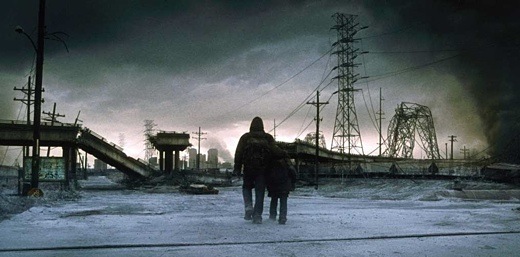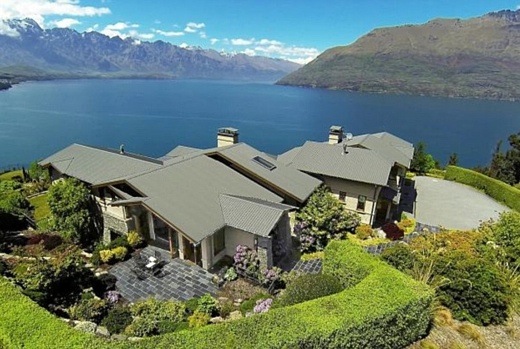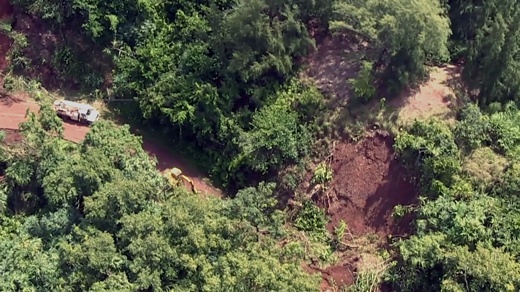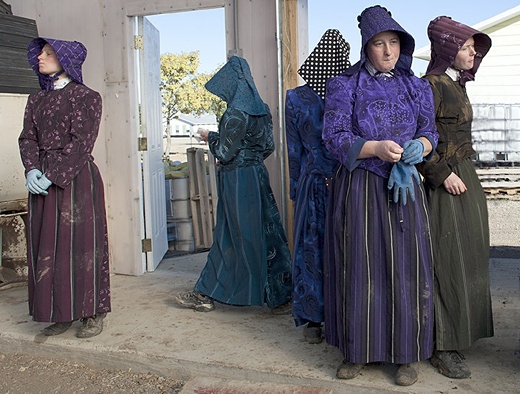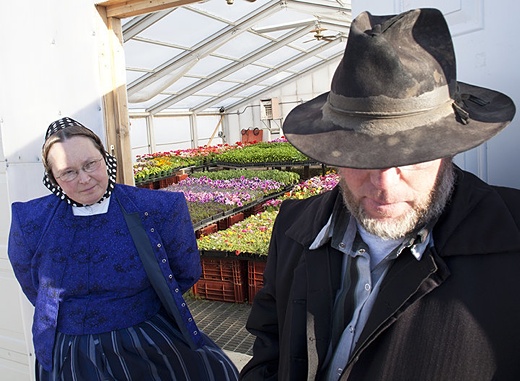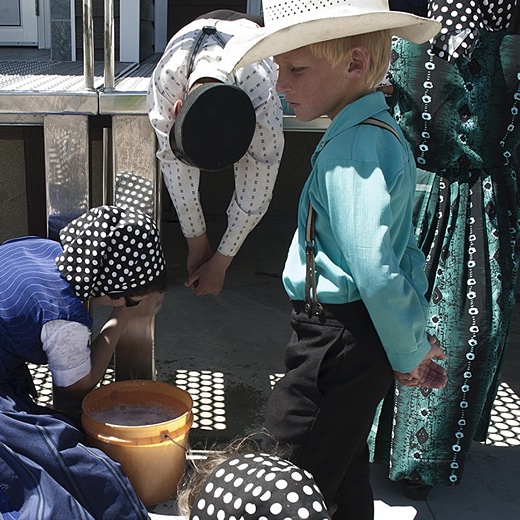SUBHEAD: Americans don’t realize how fast the country is moving toward becoming a better version of itself.
By James Fallows on 26 April 2018 for the Atlantic - (
https://www.theatlantic.com/magazine/archive/2018/05/reinventing-america/556856/)
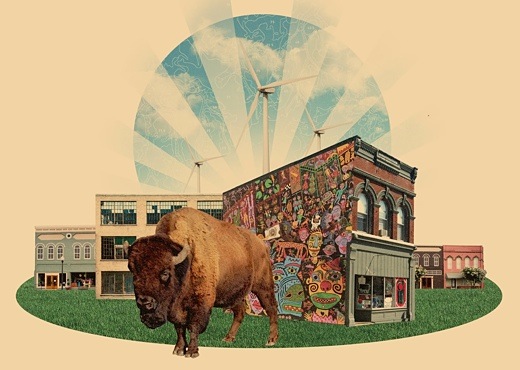 Image above: Illustration of "new" America by Mark Weaver. From original article.
Image above: Illustration of "new" America by Mark Weaver. From original article.
I have seen the future, and it is the United States.
After a several-year immersion in parts of the country that make the news mainly after a natural disaster or a shooting, or for follow-up stories on how the Donald Trump voters of 2016 now feel about Trump, I have a journalistic impulse similar to the one that dominated my years of living in China.
That is the desire to tell people how much more is going on, in places they had barely thought about or even heard of, than they might have imagined.
In the case of China, that impulse matched the mood of the times. In the years before and after the world financial crisis of 2008, everyone knew that China was on the way up; reporters like me were just filling in the details. In the case of the modern United States, I am well aware that this message runs so counter to prevailing emotions and ideas as to seem preposterous.
Everyone knows how genuinely troubled the United States is at the level of national politics and governance. It is natural to assume that these disorders must reflect a deeper rot across the country.
And indeed, you can’t travel extensively through today’s America, as my wife, Deb, and I have been doing in recent years, without being exposed to signs of rot, from opioid addiction to calcifying class barriers.
At the time Deb and I were traveling, sociologists like Robert Putnam were documenting rips in the social fabric. We went to places where family stories matched the famous recent study by the economists Anne Case and Angus Deaton of Princeton, showing rising mortality among middle-aged whites without a college degree for reasons that include chronic disease, addiction, and suicide.
In some of the same cities where we interviewed forward-moving students, civic leaders, and entrepreneurs, the photographer Chris Arnade was portraying people the economy and society had entirely left behind.
The cities we visited faced ethnic and racial tensions, and were struggling to protect local businesses against chain stores and to keep their most promising young people from moving away. The great majority of the states and counties we spent time in ended up voting for Donald Trump.
What we learned from traveling was not that the hardest American challenges of this era are illusory. They’re very real, and divisions about national politics are intense.
So we made a point of never asking, early on, “How’s Obama doing?,” or later, “Do you trust Hillary?” and “What about Trump?” The answers to questions like those won’t take you beyond what you’ve already heard ad nauseam on TV.
Instead we asked people about their own lives and their own communities. Reporting is the process of learning what you didn’t know before you showed up.
And by showing up in Mississippi and Kansas and South Dakota and inland California and Rust Belt Pennsylvania, we saw repeated examples of what is happening in America’s here and now that have important and underappreciated implications for America’s future.
Serious as the era’s problems are, more people, in more places, told us they felt hopeful about their ability to move circumstances the right way than you would ever guess from national news coverage of most political discourse. Pollsters have reported this disparity for a long time.
For instance, a national poll that
The Atlantic commissioned with the Aspen Institute at the start of the 2016 primaries found that only 36% of Americans thought the country as a whole was headed in the right direction.
But in the same poll, two-thirds of Americans said they were satisfied with their own financial situation, and 85% said they were very or somewhat satisfied with their general position in life and their ability to pursue the American dream.
Other polls in the past half-dozen years have found that most Americans believe the country to be on the wrong course—but that their own communities are improving.
What explains the gulf between most Americans’ hopeful outlook on areas and institutions they know directly and their despair about the country they know only through the news?
Would it make any difference if more people understood that the local progress they see was not an isolated anomaly but part of a trend?
I make no pretense that our proposed answers to those questions are precise or scientific. We traveled as broadly as we could.
We listened; we learned. We were looking for civic success stories, and we found them. But we also ended up in places where well-intentioned efforts had failed.
So we steadily adjusted our conclusions. We ended up convinced that the national prospect is more promising than we’d felt before we started—full of possibilities that the bleak trench warfare of national politics inevitably obscures.
My own form of American nationalism, intensified both by living outside the country and by travels within it, arises from love of the American idea: inclusion, expansiveness, opportunity, mobility, the open-ended struggle to make the nation a better version of itself.
After living in Japan during its amaze-the-world era of the 1980s, I wrote a book arguing that the proper U.S. response was not to try to be more like Japan but instead to be “more like us”—which was the book’s title. (Its subtitle was
Making America Great Again. Sigh.)
America is becoming more like itself again. More Americans are trying to make it so, in more places, than most Americans are aware.
Even as the country is becoming worse in obvious ways—angrier, more divided, less able to do the basic business of governing itself—it is becoming distinctly better on a range of other indicators that are harder to perceive. The pattern these efforts create also remains hidden.
Americans don’t realize how fast the country is moving toward becoming a better version of itself.
How can this be? Let me explain.
Six years ago, as part of
The Atlantic’s 2012 election-year coverage, Deb and I went to central Pennsylvania to watch Mitt Romney try to swing the state against Barack Obama. Romney did what he could. Obviously he fell short, but what stayed with us was the landscape he passed through.
Romney rode from one forlorn coal or manufacturing community to another in a big chartered bus that had iconic small-town scenes painted on its sides, along with the slogans “Believe in America” and “Every town counts.”
In an old battered metal-casting shop in Weatherly, in Carbon County, he talked to a nearly all-white crowd about the region’s loss of factory jobs and the need to bring them back. “This is about saving America!” he said.
During the Pennsylvania part of Romney’s tour, which then went on to Ohio, we stayed in a cheap motel in the hard-luck coal-country town of Hazleton, where the median household income, in the low $30,000s, was much less than the national level of more than $50,000 and the unemployment rate, about 15% at the time, was much greater.
The few visible signs of after-dark life were bodegas on downtown Wyoming Street, serving the city’s growing Latino population.
When we got back from dinner at a small Mexican restaurant, we channel surfed to a local-access TV station and saw Lou Barletta, the longtime Republican mayor of Hazleton who had recently made it into Congress as part of the 2010 Tea Party wave, warn that ongoing immigration was a threat to Hazleton’s safety and quality of life.
As mayor, Barletta had been a proto-Trump, championing a city ordinance that, among other anti-immigrant provisions, declared English the “official language” of Hazleton and required that official city business be conducted in English only. The measures were eventually tossed by federal courts.
If Deb and I could have been transported one presidential-campaign cycle into the future, we would of course have realized that the conditions we saw in Pennsylvania prefigured what would become the standard explanation for Donald Trump’s eventual rise.
The smaller communities with mainly white populations, where immigrants were cast as symbols of a threatening future and boarded-up storefronts and abandoned mill buildings served as humiliating daily reminders of lost economic strength—the main journalistic question, looking back at the 2016 results, was why such places would not have gone for Trump.
Those days also prefigured a view of politics for us, but of a very different sort. After visiting Weatherly and Hazleton and their neighbors, Deb and I wondered why we hadn’t been to more such places, in other parts of the country.
Traveling as frequently as we could outside the big cities had been our main approach to journalistic—and cultural, and personal—discovery during our years in China.
Why not try a similar approach here? Starting in 2013, that is what we did, flying from town to town in our small propeller plane, which itself provided a close-up view of how cities fit into the American landscape.
We reported on our findings along the way online and in print for
The Atlantic, and a book about the results,
Our Towns: A 100,000-Mile Journey Into the Heart of America, will appear this month.
Skeptics will wonder at our wonder, and start by asking whether our impressions were distorted by a selection bias among cities. To some degree, sure.
When we originally asked on
The Atlantic’s website for suggestions of cities with instructive stories, we often heard about regional successes, or the more fortunate part of a compare-and-contrast pair.
For instance: Burlington, Vermont, has had a more positive recent history than Plattsburgh, New York, its neighbor across Lake Champlain.
The same is true of Greenville, South Carolina, whose collection of small, mutually competitive companies during the textile-economy era helped it adjust more nimbly to the post-textile age than the nearby city of Spartanburg, whose textile economy had centered on one giant firm.
But as time went on we focused on harder-pressed places.
In Mississippi, we spent weeks in some of its traditionally lowest-income areas.
In California, we concentrated on the state’s most troubled city, San Bernardino, and one of its perennially least fashionable, Fresno.
In central Oregon, we visited onetime lumber towns whose unemployment rates had been among the worst in the nation when the timber economy collapsed in the 1980s and again after the world financial crisis 10 years ago.
We ended our journey in Erie, Pennsylvania, at about the time that Donald Trump was holding rallies there saying its economy was a symbol of American collapse.
Wherever we went, we heard about efforts that had succeeded—and also those that had failed.
During our travels I exchanged notes on Twitter with Chris Arnade about his photos (some published by
The Atlantic) of people in a certain city being left behind and our profiles of the go-getters trying to move that same city ahead.
Could these contrasting portrayals both be true?
The answer, I think we agreed, is that we were trying in our complementary ways to portray parts of the contradictory American whole, which at every stage has involved both progress and cruel dislocation.
Back during the “Morning in America” 1980s, I spent weeks in the Texas oil fields and in Michigan and Chicago’s South Side reporting on people who’d been displaced by trade and technology.
To read American history is to know that in every era people have been forced to change occupation and location.
Many of the Anglo families in my inland-California hometown of Redlands had left the South and the Midwest starting in the Dust Bowl years; many of the Latino families had fled north after the Mexican Revolution of 1910.
Were we mistaking anecdotes and episodes for provable trends?
This is the occupational hazard of journalism, and everyone in the business struggles toward the right balance of observation and data. But the logic of reporting is that something additional comes from traveling, asking, listening, seeing.
This is particularly true in detecting a sense of changed course. A political movement, a new technological or business possibility—I have learned through the decades that enthusiasm in any of these realms does not guarantee world-changing success, but it’s an important marker.
The visionary California entrepreneurs I wrote about in the 1980s were confident that their Osborne and Kaypro computers would change the world. They were wrong.
The visionary California entrepreneurs I met at Apple in those same years were confident that their dreams would come true. They were right.
And enthusiasm is what we have seen.
This disparity in enthusiasm is especially striking in generational terms. Through American and world economic history, the cruel reality of technological dislocation has been that people who lose their jobs in middle age almost never become whole again, financially or socially.
This is terrible, but it has always been true. It means that the obligation of an equitably growing economy is both to support people who have suffered economic damage and to do everything possible to improve prospects for their children.
Thus we took it seriously when people in their 50s or 60s described what they’d lost when a mine or factory closed.
But we also took it seriously, and as an indication of a community’s future prospects, when people in their 20s and 30s talked about the new opportunities they saw, from agriculture-related start-ups in Kansas and South Dakota to advanced-manufacturing ventures in Kentucky and Michigan.
In what underpublicized ways is America moving forward locally and regionally, while we read only about chaos and discord nationally?
To summarize a few:
Civic governance
Even as national politics induces distrust and despair, most polls show rising faith in local governance. For instance, surveys typically find that only a quarter of Americans trust the national government to “do the right thing,” but Gallup polls in 2014 and 2016 found that more than 70 % trusted their local government to do so.
Part of this could be explained by people self-selecting into more-homogeneous communities. But in our experience it was true even in cities with significant racial and economic diversity, from Greenville to Fresno, Los Angeles, and San Bernardino.
Mayors serve multiterm stints, launch long-range projects, realize that they’ll encounter in daily life their neighbors who pay the city’s taxes and rely on its services. I could spend the rest of this article describing initiatives that tech companies are launching and refining to improve the quality, responsiveness, and accountability of city services.
Even as arguments about tax cuts or increases have degenerated into religious war at the national level, we saw them discussed in what you could call reasonable terms locally. Dodge City, in western Kansas, is very conservative in national politics.
But everyone we met there stressed the importance of its “Why Not Dodge?” sales-tax increase, which citizens had approved in the late 1990s in a referendum. The proceeds had paid for parks, public swimming pools, and other facilities.
In the same 2014 election in which West Virginia voters removed the very last Democrat from the state’s congressional delegation, the taxpayers of the capital city, Charleston, voted for a levy to sustain their public libraries.
Even as the local and national economy collapsed in 2009, the mayor of Columbus, Ohio, urged his citizens to approve a tax increase rather than curtail city services and lay off employees, and they agreed.
Immigration
Even as the national discussion grows more hateful, the lived reality of absorbing immigrants and refugees has remained remarkably calm—in the cities where they have actually arrived.
Pew, like other polling organizations, periodically asks Americans which national problems concern them most.
Through the five years before Donald Trump’s election, immigration rarely made the top five. (The economy usually leads.) A Gallup poll conducted six months after his inauguration found that nearly two-thirds of Americans felt the level of immigration should either stay the same or go up.
During the 2016 “Brexit” campaign, polls indicated that the communities in the United Kingdom most fearful of an immigrant presence were those where the fewest immigrants had ever come. American polls strongly indicate the same pattern.
Steve King, a Republican who is the most outspokenly anti-immigrant member of Congress, represents a district in Iowa that is 93% white; representatives from districts along the U.S.–Mexico border, Republican and Democrat alike, are more relaxed about the immigrant “threat” and either outright oppose or only tepidly support plans to “build the wall.”
Whereas immigrants congregate in big cities such as Chicago and Los Angeles, many refugees are sent to medium-size communities that have specialized in assimilating them, a process we saw in, for instance, South Dakota, Vermont, Minnesota, and Pennsylvania, among other states.
Midwestern industrial cities that have lost some of their home-born population have pushed hard for outsiders to revitalize them.
Erie was a magnet for eastern-European and other immigrants during its manufacturing heyday, from the mid-19th through the mid-20th centuries.
Now refugees, including recent arrivals from Syria, make up fully 10% of its population, and they supply much of its entrepreneurial energy.
In 2006 a group called Welcoming Tennessee began celebrating the importance of immigrants and refugees to Nashville’s economy. It has spread to become Welcoming America, supporting immigrant and refugee settlement in more than 50 cities.
Talent Dispersal
Even as ambition, money, opportunity, and innovation cram ever more tightly into New York, San Francisco, Seattle, and elsewhere, a discernible “reverse talent migration” is taking place.
In Wichita, Kansas; in Bend, Oregon; in Duluth, Minnesota; in Sioux Falls, South Dakota; in Fresno, we found people who had already worked in the most expensive and “elite” cities or who had been recruited for opportunities there, and decided instead that the overall life balance was better someplace smaller and less expensive.
Steve Case, a co-founder of AOL and now the CEO of the technology-investment firm Revolution, has for several years led “Rise of the Rest” tours across the country to promote new tech businesses and support existing ones in places other than the famous tech centers.
“For half a century, there’s been a brain drain, as people who grew up in the ‘rest of America’ left their hometowns for better opportunities elsewhere,” Case told me recently. Case himself grew up in Hawaii but built his companies in the Washington, D.C., area.
“We’re starting to see less of that brain drain. We’re seeing more graduates stay in place, in cities like Pittsburgh or Columbus, and a boomerang of people returning to where they’re from—for lifestyle reasons, and because they can see that their communities are rising and opportunities are increasing, and they’d like to be part of what’s going on.”
Case points out that venture-capital support for start-ups is still heavily skewed toward the coasts. Nearly half of the total funds in the U.S. are directed to companies in California alone.
But he says the balance is shifting, as part of a “third wave” of technology businesses (the first the building of the internet, the second the building of companies using it) based on applying advanced technology to “real” enterprises, from agriculture to health care to manufacturing.
“It’s going to be more important to know how doctors work and farmers think and to build strategic partnerships,” he told me, “than just to work on coding and software.” The coding and software centers are in a handful of big cities.
These other businesses are dispersed across the country, and start-ups will follow. “We see the ecosystems developing—mayors working with entrepreneurs and university presidents,” Case said. “Things are bubbling in these cities. It’s an untold story.”
“Young people want to live in the city again, and they’re reviving it,” a tech-company founder named Doug Pelletier told us in Allentown, Pennsylvania, explaining why he had moved his headquarters from the suburbs to the long-troubled but improving downtown. It was a story we heard time and again.
Igor Ferst, a Millennial engineer who had worked for Google and other famous companies in California, wrote us to describe why he and his wife had decided to move to Columbus. “The biggest improvement to our quality of life is not a lower median house price (though that doesn’t hurt),” he said.
“Rather, it is a sense of freedom that comes from finding personal and professional fulfillment in a vibrant and welcoming city, away from the Bay Area’s grinding commutes and careerist, status-obsessed culture.”
Schools
Even as Americans lament the decline of public education nationwide, and even as funding pressures remain acute—especially in Pennsylvania, whose funding system is the most cruelly inequitable, district by district, of any state’s—in most places we went people were eager to show us their innovative local schools.
Some were public boarding schools, such as the “Governor’s Schools” we saw in Mississippi and South Carolina, where students from across the state live and study during part of their high-school years.
Many schools worked with local employers to train students for decently paying jobs in culinary, architectural, mechanical, agricultural, medical, and other fields.
Community colleges and universities increasingly provide the connective tissue among the components of a healthy regional economy: established companies, start-up entrepreneurs, academic researchers, and future employees.
For instance, Wichita, which calls itself “the air capital of the world,” has large manufacturing complexes making Cessna and Beechcraft private jets and fuselages for Boeing airliners.
Wichita State University runs the National Institute for Aviation Research, where I saw students and professors working on projects to improve aircraft design and reduce crash risks.
Airbus recently moved a major engineering center into a new building on the Wichita State campus.
Libraries
Libraries might seem fated to become the civic counterparts of yesteryear’s Borders or Barnes & Noble, but in nearly every city we visited they were newly prominent.
By most measures of use—classes and programs offered, daily attendance, visits to the website, everything except calls to reference librarians for the research people can now do on Google—libraries are becoming more rather than less popular and central to civic life.
The soft measures of impact are powerful: Walk into a random public library, and you’ll see waiting lines for computers, librarians helping with job searches or other practical concerns, desk space for young entrepreneurs.
According to a recent Pew survey, Millennials use libraries more than their Gen X or Boomer elders do.
Manufacturing
Even as Americans look out their windows from the Amtrak routes along the East Coast or from Midwest interstates to see derelict abandoned steel or car factories, almost every city we visited featured smaller advanced-tech workplaces.
The federal government’s Manufacturing Extension Partnership, a modern counterpart to its long-established agricultural-extension programs, says it has worked with more than 1,000 successful manufacturing start-ups around the country.
In Allentown, what was once the factory headquarters for Mack Trucks is now an incubator with a stream of new small companies.
Going to the FirstBuild manufacturing incubator in Louisville, Kentucky, in 2016 reminded me of being in China—in a good way, for the intensity of maker-style innovation on the shop floor.
FirstBuild was started by General Electric and is now owned by the Chinese appliance manufacturer Haier, but it still trains young workers and fosters new businesses in Louisville.
Downtowns
Even as the country looks more homogenized and faceless in the parking lots of big malls, downtown by downtown it looks more distinctive and local.
The Main Street America project of the National Trust for Historic Preservation reports more than 1,000 downtown-revitalization efforts now under way. Downtown reinventions that have already been successful—in places like Burlington and Greenville and Bend—illustrate the model of combining residences, shopping, and dining and entertainment for downtowns that are still on the way back, as in Allentown and Duluth and Macon, Georgia.liance manufacturer Haier, but it still trains young workers and fosters new businesses in Louisville.
Conversation
Even as Donald Trump’s federal government dismantles environmental protections and exposes national monuments and wildlife refuges to drilling, states, localities, and private donors are setting aside land for conservation at an impressive pace.
It would be better if the federal government were working with them rather than working against them. (It would be better if this paragraph and the others like it didn’t have to begin “Even as
…”)
But these efforts are a counterpart to the response that the governors of 16 states plus the territory of Puerto Rico and nearly 400 mayors made to Trump’s announcement that he was leaving the Paris Agreement: Their states and cities, which together account for more than half of U.S. economic output, would continue to observe the Paris climate goals.
To a remarkable degree, political and journalistic portrayals suggest that coastal big-city America is the place where things happen. Washington means government, New York means finance, Los Angeles means entertainment, San Francisco and Seattle mean tech.
As for people elsewhere, they’re the ones things happen
to. Globalization, drought, layoffs, opioids—these are the blows that fall one by one on smaller-town and rural Americans.
No wonder they’re so mad. But Deb and I have seen other kinds of things happening—and
in these places, not just
to them.
The hardest question is whether something has changed since the last presidential campaign and election to make any optimism about local-level realities outdated, and to suggest that the poison of national politics has seeped all the way down.
There is of course evidence that this has happened, in the form of the bigotry that has been unleashed since 2017.
In the months after Donald Trump took office, we checked back with communities where we’d met immigrants and refugees. Some places had seen a nasty shift, as Immigration and Customs Enforcement agents and police became newly aggressive and local racists felt empowered.
A few months before the election, we interviewed Catholic nuns and secular volunteers in Garden City, Kansas, who were bringing surplus food and medical supplies to poor households, many of whose members were immigrants working in the area’s vast beef-packing complex.
A few months after the election, a white-extremist hate group in Garden City was arrested while plotting to blow up an apartment building where African immigrants and refugees lived. In Dodge City, we met and wrote about a rising, respected young city-government official named Ernestor de la Rosa.
His parents had brought him to the U.S. from Mexico when he was a child, and he had stayed in the country as a “Dreamer,” on a Deferred Action for Childhood Arrivals waiver, while working toward an advanced degree at Wichita State. Trump carried Dodge City more than two to one.
But people we spoke with there after the election said they never intended their preference in national politics to lead to the removal of trusted figures like de la Rosa.
You could use the Dodge City story for snark: What did Trump supporters
think they were voting for? Two days after the election, Deb and I were in Wyoming, where Trump beat Clinton more than three to one.
Most people we interviewed there were happy about his victory—but hoped it would not lead to either an interruption in
NAFTA, which was important for their exports, or a change in the availability of an immigrant labor force.
Contradictory outlooks?
Yes. But to us the incoherence of these views said less about the people holding them than about the gulf between many Americans’ outlook on national partisan issues—polarized, tribal, symbolic—and the practical-mindedness with which most people in most regions approach decisions about their own communities.
Dysfunction at the national level genuinely
is a problem, as the world is reminded every time the federal government shuts down.
Some of that pathology has spread to the state level.
But for us the American story was of a country that is still capable of functioning far more effectively than national-level paralysis would indicate or than most people unaware of the national patterns we are reporting would assume about the parts of America they’re not in.
Suppose you are skeptical of this fundamental claim, about the ongoing health of local American society. I suggest the following test, and mean it seriously rather than just as a thought experiment:
Through the next year, go to half a dozen places that are new to you, and that are not usually covered in the mainstream press. When you get there,
don’t ask people about national politics.
Trump, Hillary Clinton, the Russians, the Mueller investigation—if it’s on cable news, don’t ask about it. Instead ask about what is happening right now in these places.
The schools, the businesses, the downtown, the kind of people moving out and the kind moving in, and how all of this compares with the situation 10 years ago. This process, repeated again and again, led us to the perspective I am presenting here.
But suppose you accept the idea that America is remaking itself except at the national level. What difference would that make? Here are three areas in which our reporting has changed my mind about what really matters.
First is improving
connections, both conceptual and operational. Across the country, millions of people in thousands of organizations are working toward common goals, generally without being aware of how many other people and organizations are striving toward the same end.
The more we traveled, the more parallels and resonances we saw. This public-art project in southern Arizona was like that other one in Maine. This library program in Oregon was like that one in Ohio. This creative public school in California was like that one in Georgia.
This conservation effort in Montana resembled others in California, and Louisiana, and Idaho. This “civic tech” project we heard about in Massachusetts was like the ones we learned about in Indiana and in Southern California. Every place had its local features, but together those efforts formed a pattern whose sweep and power can be hard to discern from any single instance.
Recognizing that these emerging networks exist in parallel is important in practical terms, so that people can share examples of success, plus increase the networks’ collective leverage. It matters at least as much in outlook.
It’s one thing to work in what you imagine to be a lonely outpost, defending yourself against decline all around. It’s different and more exhilarating to know that you are part of something bigger, and that you are going down a path others have helped blaze.
Second is emphasizing
engagement, of almost any kind. I’d always known about this as a platitude, or as the academic concept of “social capital.”
Now I understand it as a tangible thing. Early in our travels I received a note from a young man who had moved from a big coastal city to a town in North Texas. “If you want to
consume a fabulous community, you could move to some place like Brooklyn,” he said—or San Francisco, or Seattle, or Paris, or Amsterdam, or any other glittering site with restaurants, parks, vistas, and public spaces to enjoy.
“If you want to
create a great community, you move someplace that needs your help,” like his new hometown.
Creating in this sense means taking responsibility for the invention and sustenance of the community in which you’d like to live.
The idea of engagement, then, boils down to sharing responsibility for the world outside one’s individual household.
Any step in that direction—as modest as voting or attending PTA meetings, as dramatic as running for office or leading a group to deal with local problems—is a step that encourages civic creation, not just consumption.
And the evidence of past waves of reform, from the labor-rights and women’s-suffrage movements of the early 1900s through the civil-rights and environmental movements of mid-century, suggests that national transformations must start from local roots.
Third is correcting
perceptions and dealing with what is already recognized as a national emergency: the distorted picture of events beyond our immediate experience that comes through the media, professional and informal alike.
The strain on local media, whose effects we saw everywhere, is an important part of this distortion. One to-do step for citizens: Subscribe to local publications while they still exist.
A to-do step for plutocrats and philanthropists: View news-gathering as a crucial part of the public infrastructure of this era, just as Carnegies, Rockefellers, and Mellons viewed libraries, museums, and universities as part of the necessary infrastructure of their time.
The most urgent place to start would be with local and state-capital newspapers, which have been even harder hit than national publications by the evaporation of journalism’s late-20th-century economic base.
The challenge of journalism is always to make what’s important interesting. This is hard enough in the best of circumstances. It’s harder when the reality you’re conveying involves a mixture of developments both encouraging and alarming, rather than a stark exposé or a success story. It’s harder still when the reality involves TV and video.
And it is nearly impossible in the case of cable-news channels, above all politically driven ones like Fox. What 24-hour cable news introduced and Fox perfected in the modern news consciousness is an unending stream of horrors from … somewhere else.
The natural result of well-meaning liberal media is thus a kind of pity for the heartland, and of conservative media, a survivalist fear about what people Out There are trying to get away with.
The problems of journalistic proportion hardly began with the last presidential campaign. You name a decade from the 1700s onward, and I can show you an essay on the failings and pernicious effects of the contemporary press.
But those defects crest in certain eras, and Americans’ inability to see clearly the state of their nation represents one of those dangerous peaks now.
A clear view of the America of this era contains serious perils, like always, but also more promise than at many other times. Through the long saga of American reinvention, the background question has been the one Benjamin Franklin is said to have pondered at the Constitutional Convention when looking at a painting of the sun on the back of George Washington’s chair.
Franklin said that he had “often and often” looked at that sun “without being able to tell whether it was rising or setting.”
As the Constitution was being signed, Franklin declared that he had “the happiness to know” the sun was rising. It can rise again, and across the country we have seen rays of its new light.
>
